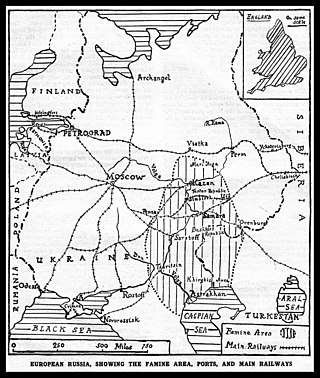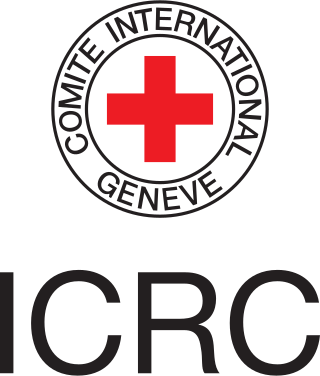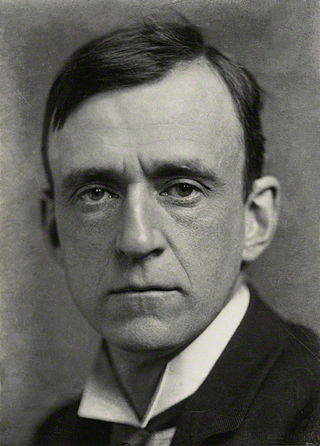Related Research Articles

The organized International Red Cross and Red Crescent Movement is a humanitarian movement with approximately 16 million volunteers, members, and staff worldwide. It was founded to protect human life and health, to ensure respect for all human beings, and to prevent and alleviate human suffering.

Post-Impressionism was a predominantly French art movement that developed roughly between 1886 and 1905, from the last Impressionist exhibition to the birth of Fauvism. Post-Impressionism emerged as a reaction against Impressionists' concern for the naturalistic depiction of light and colour. Its broad emphasis on abstract qualities or symbolic content means Post-Impressionism encompasses Les Nabis, Neo-Impressionism, Symbolism, Cloisonnism, the Pont-Aven School, and Synthetism, along with some later Impressionists' work. The movement's principal artists were Paul Cézanne, Paul Gauguin, Vincent van Gogh and Georges Seurat.

George William Frederick Villiers, 4th Earl of Clarendon, was an English diplomat and statesman from the Villiers family. Following diplomatic postings, he served a succession of Whig and Liberal administrations. This included as Viceroy in famine-stricken Ireland and, on the first of three occasions as Foreign Secretary, as the United Kingdom's chief representative at the Congress of Paris which ended the Crimean War.

Harold Lloyd "Harry" Hopkins was an American statesman, public administrator, and presidential advisor. A trusted deputy to President Franklin Delano Roosevelt, Hopkins directed New Deal relief programs before serving as the eighth United States secretary of commerce from 1938 to 1940 and as Roosevelt's chief foreign policy advisor and liaison to Allied leaders during World War II. During his career, Hopkins supervised the New York Temporary Emergency Relief Administration, the Federal Emergency Relief Administration, the Civil Works Administration, and the Works Progress Administration, which he built into the largest employer in the United States. He later oversaw the $50 billion Lend-Lease program of military aid to the Allies and, as Roosevelt's personal envoy, played a pivotal role in shaping the alliance between the United States and the United Kingdom.

Hans-Valentin Hube was a German general during World War II who commanded armoured forces in the invasions of Poland, France and the Soviet Union. In the course of the war, Hube led the 16th Infantry Division, XIV Panzer Corps, and the 1st Panzer Army rising to the rank of Generaloberst. He died in an air crash on 21 April 1944.

The Russian famine of 1921–1922, also known as the Povolzhye famine was a severe famine in the Russian Soviet Federative Socialist Republic that began early in the spring of 1921 and lasted until 1922. The famine resulted from the combined effects of severe drought, the continued effects of World War I, economic disturbance from the Russian Revolution, the Russian Civil War, and failures in the government policy of war communism. It was exacerbated by rail systems that could not distribute food efficiently.

Charles Robert Ashbee was an English architect and designer who was a prime mover of the Arts and Crafts movement, which took its craft ethic from the works of John Ruskin and its co-operative structure from the socialism of William Morris.

John Edward McKenzie Lucie-Smith, known as Edward Lucie-Smith, is a Jamaican-born English writer, poet, art critic, curator and broadcaster. He has been highly prolific in these fields, writing or editing over a hundred books, his subjects gradually shifting around the late 1960s from mostly literature to mostly art.

The International Committee of the Red Cross (ICRC) is a humanitarian organization based in Geneva, Switzerland, and is a three-time Nobel Prize laureate. The organization has played an instrumental role in the development of rules of war and promoting humanitarian norms.

David Vogel was a Ukrainian-born Jewish poet, novelist, and diarist.

Henry Tonks, FRCS was a British surgeon and later draughtsman and painter of figure subjects, chiefly interiors, and a caricaturist. He became an influential art teacher.

The Medal of French Gratitude was a French honour medal created on 13 July 1917 and solely awarded to civilians. The medal was created to express gratitude by the French government to all those who, without legal or military obligation, had come to the aid of the injured, disabled, refugees, or who had performed an act of exceptional dedication in the presence of the enemy during the First World War. The creation of this distinction was mainly the result of unsuccessful offensives of General Nivelle in 1917 and the serious crisis of confidence in France. The French government thus wanted to thank those who, despite the crisis, were always volunteering. It has three classes: bronze, silver, and gold. Nearly 15,000 people and communities were recipients of this award. The medal is no longer awarded, the last award was on 14 February 1959.
The Commission for Polish Relief (CPR), also known unofficially as Comporel or the Hoover Commission, was initiated in late 1939 by former US President Herbert Hoover, following the German and Soviet occupation of Poland. The Commission provided relief to Nazi occupied territories of Poland until December 1941.
Conrad Hoffmann Jr. was an American Christian missionary who aided war prisoners, European university students, and war refugees during both World Wars.
The World university Service (WUS) is an international organisation founded in 1920 in Vienna as an offshoot of the World Student Christian Federation to meet the needs of students and academics in the aftermath of World War I. After World War II, it merged with European Student Relief to become International Student Service and eventually WUS in the 1950s. In the 1970s it began to focus on campaigning for educational rights for the disadvantaged.

Robert Mountsier (1888-1972) was an author, journalist and literary agent for writer D.H. Lawrence.
Ella Atherton was a Scottish-born actress, fashion model, horse breeder, and Socialite, who married an Indian maharaja, Vijayasinhji Chhatrasinhji in 1940. After marriage, she was also known as Ila Devi Rajpipla; Maharani Ella Devi of Rajpipla or H.H. Maharani Ella Devi Sahiba.
Leslie Lesser Landau was a British director, film producer, screenwriter, screenplay editor and playwright. He also served as the newsreel editor of British Movietone News from 1929 to 1935 at a time the power of newsreel from a political perspective was first used. He was honoured for landmark film journalism.
Aline Sybil Atherton-Smith was an English born Quaker, who worked as an International refugee relief worker and writer, focused initially with duties for the British Red Cross, followed by humanitarian aid in France, and subsequently in Central Europe with the Friends' War Victims Relief Committee. She was a member of the Friends Council for International Service. As an activist for peaceful causes, she assisted displaced persons, and aided the Serbs in France in the aftermath of First World War. In 1940, her name appeared on the Nazis' most wanted list drawn up prior to their intended invasion of Britain.

Anna Milo Upjohn (1868–1951) was an American artist, illustrator, author, and relief worker who, late in her long career, became known for paintings, drawings, and illustrations she made for the American Red Cross. After graduating from high school, she studied art briefly in New York but obtained most of her training in Paris from Claudio Castelucho and Lucien Simon. In the early years of the twentieth century, she became known both for her portraits and paintings of children and for her book and magazine illustrations. Finding herself in France at the outset of the First World War, she devoted herself to relief work first among the refugees in Paris and later among the devastated villages in France and Belgium. Having spent the first half of her adult life as an independent professional, she served as a staff artist for the American Red Cross between 1921 and 1931. She traveled extensively during her adult life and lived mostly in New York City; Ithaca, New York; and Washington, D.C.
References
- ↑ "Image of David Atherton-Smith".
- ↑ "Medal card of Smith, David Atherton Corps: French Red Cross". www.discovery.nationalarchives.gov.uk/.
- ↑ "Exterior of the school founded by the American Red Cross for the re-education of mutiles. Capt. Atherton-Smith, in charge of this work, assisting Miss Grace Harper, Chief of the Red Cross Bureau of Re-education". www.loc.gov/.
- ↑ "Artists Biographies: Atherton-Smith".
- 1 2 "Atherton-Smith, David" . Benezit Dictionary of Artists. Benezit Dictionary of Artists. 2011. doi:10.1093/benz/9780199773787.article.B00008203. ISBN 978-0-19-977378-7.
- 1 2 3 4 5 "Nannette Atherton-Smith in the England & Wales, Civil Divorce Records, 1858-1918: Wife's petition for a divorce". ancestry.com. 2014. pp. 1–17.
- ↑ "David Atherton-Smith ancestry".
- ↑ "Atherton-Smith first appearance at the Queen's Hall, March 21, 1898". Black and White, Mar 26. 1898. p. 30.
- ↑ "A night with Burns: Grand Annual Scottish Concert". London Standard, Jan 22. 1903. p. 1.
- ↑ "Miss Josephine Patten, accompanied by David Atherton-Smith and Lucie Mawson". London Standard, Nov 26. 1902. p. 1.
- ↑ "Baritone Atherton-Smith at Bechstein Hall". London Echo, Nov 19. 1902. p. 2.
- ↑ MacCarthy, Fiona (2014). The Simple Life: C.R. Ashbee in the Cotswolds. Faber & Faber. p. 23. ISBN 9780571320219.
- ↑ Ashbee, Felicity (2002). Janet Ashbee: Love, marriage, and the arts & crafts movement. Syracuse University Press. p. 28. ISBN 9780815607311.
- ↑ "Who's who in Music: A Biographical Record of Contemporary Musicians". Pitman. 1915. p. 261.
- ↑ Shaw, Bernard (1986). Bernard Shaw, the Diaries, 1885-1897: With Early Autobiographical Notebooks. Pennsylvania State University Press. ISBN 9780271003863.
- ↑ Special Relationships. Manchester University Press. 2018. ISBN 9781526137654.
- ↑ "Atherton-Smith - Dalmas marriage". Daily Mail, Jul 30. 1903. p. 1.
- ↑ "Divorce Court File: 2684. Appellant: Nannette Atherton-Smith. Respondent: David Atherton-Smith". discovery.nationalarchives.gov.uk/.
- ↑ "Exhititions by Atherton-Smith". worldcat.org.
- ↑ "Artists Biographies: Atherton-Smith".
- ↑ Bénézit, Emmanuel (2006). Dictionary of Artists: A - Bedeschini. Gründ. ISBN 9782700030709.
- ↑ "French Red Cross: David Atherton Smith" . Fold3. British Army World War I Medal Rolls Index Cards, 1914-1920.
- ↑ "Letter from A S Atherton-Smith to Miss Wallis".
- ↑ "Mutiles at work in the American Red Cross School Saint-Maurice, Seine. Capt. Atherton-Smith, American Red Cross (A.R.C.) in the centre of the picture supporting the Re-education of French mutiles". U.S. Library of Congress. 1919.
- ↑ "The BAE News". United States. Bureau of Agricultural Economics Library. 1923. p. 17.
- ↑ "Friends War Victims Relief Committee (FWVRC)". quakersintheworld.org.
- 1 2 3 4 "University of Vienna Medal of Honor: David Atherton-Smith".
- ↑ "Image of Mr Atherton-Smith honoured by the University of Vienna on December 22, 1922".
- ↑ "Hitler's Black Book - Original list ID A78: Details relating to whereabouts of Aline Sybil Atherton-Smith". forces-war-records.co.uk. Retrieved 22 November 2022.
- ↑ "Hitler's Black Book - Original list ID S1-104: Aline Sybil Atherton-Smith". forces-war-records.co.uk. Retrieved 21 November 2022.
- ↑ "England & Wales Civil Registration Death Index: Entry for David Atherton-Smith". Ancestry.com.
- ↑ "England & Wales, Death Registration for Aline S. A. Smith". Ancestry.com.